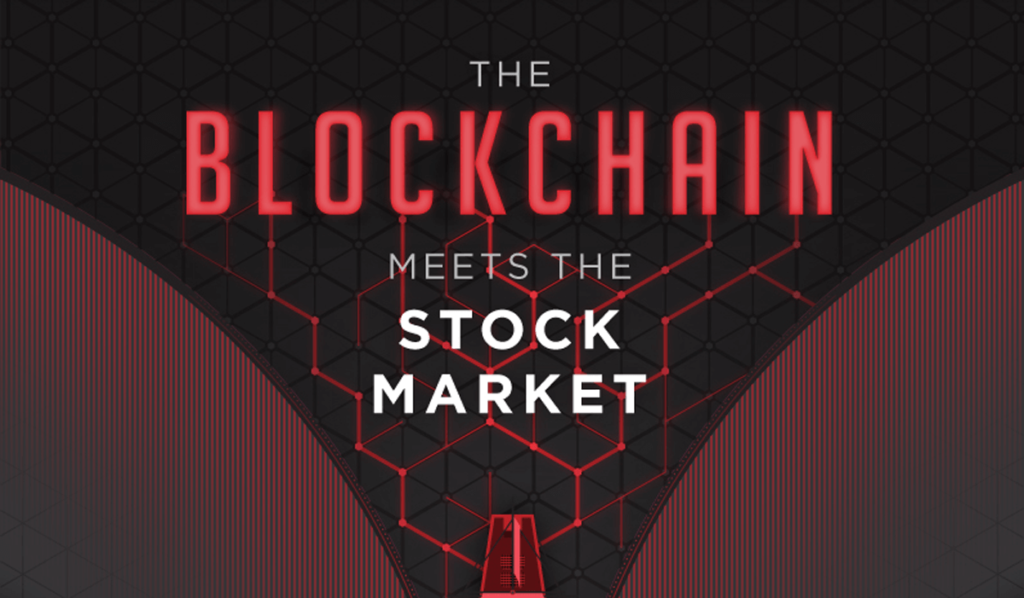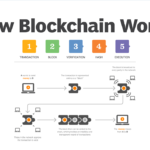Blockchain Stock Market Infographic. This infographic explores how the blockchain could transform the stock market.
The application of blockchain technology has the potential to modernise and transform the stock market. Blockchain technology has the capability to speed up complex transactions. To understand the extent of this transformation of how the blockchain transform the stock exchange you need to look at the history behind the current model.
Blockchain Stock Market Infographic – A Brief History
The modern stock market can be traced back to Amsterdam in the year 1602, when the Dutch East India Company became the world’s first “publicly traded” company.
The trade missions to the West Indies were risky and expensive. Shares and bonds were sold to a large pool of interested investors to spread the risk for these ventures. In return, backers of the company received a guarantee of some future share of profits.
As investors began speculating about the prospects of the Dutch East India Company, a second market quickly developed for these securities. People bought and sold stock in high volumes, and a central registrar tracked the transfer of shares between parties.
Blockchain Stock Market Infographic – Today’s Market
Sone four hundred years later and the stock market is not much different from the early exchange formed in Amsterdam.
Although modernised by computers and the internet, the same concepts of the market hasn’t changed at all.
Stock Transfer Agents are the centralised registrars in the background that track share ownership for issuers and the stock market. They are a third party that cancel the share certificate for the investor that sold the shares, and substitute the new owner’s name on the official master shareholder listing.
There are over 130 stock transfer agents in the USA and Canada, maintaining the records of more than 100 million shareholders on behalf of over 15,000 issuers.
Blockchain Stock Market Infographic – The Problem With The Current System
While modern stock transfer agents use today’s technology, the same old model persists – and it creates multiple problems:
Centralised and expensive
- Depositories and transfer agents are a single point of failure
- Registration, transfer, distribution, scrutineering, courier fees
- The more widely held, the higher the administration costs
- Limited Transparency
- Information asymmetry leads to market advantages
- Forged securities still a concern
- Counterparty risk is systemic
- Furthermore, legal ownership rests with transfer agents in most jurisdictions. Investors actually do not have title.
To put things into perspective you need to appreciate the size of the industry. Just one company, The Depository Trust & Clearing Corporation (DTCC), which is the highest financial value processor in the world with $1.6 quadrillion in transactions in 2016.
The Problem with Centralisation
The problems of increased centralisation and limited transparency became clear during the Financial Crisis. Companies like Lehman Brothers and MF Global went under and nobody knew what kind of assets they had off their balance sheets.
If the blockchain was used at that time, all of Lehman’s transactions would have been available. Lehman’s prudential regulators could have simply used data mining tools, smart contracts and other analytical applications to recognise anomalies. Regulators could have reacted sooner to Lehman’s deteriorating creditworthiness.
The lack of clarity and risk helped created a downward spiral of uncertainty which ultimately was a catalyst for panic. Because no one could quantify the risks, investors liquidated their assets. More selling meant even less liquidity.
Blockchain Stock Market Infographic – Enter The Blockchain
Instead of putting all stock transactions through a centralised hub, the blockchain can directly transfer share ownership between investors.
Here’s how a decentralised securities platform could work:
- Somebody decides to transfer a security.
- The transaction is broadcast to a P2P network consisting of computers known as nodes.
- The network of nodes validates the transaction and user’s status using known algorithms. A valid transaction will transfer the title of the security.
- Once verified, the transaction is combined with other transactions to create a new block of data for the ledger and thus completing the transaction.
- In other words, stock exchanges could run using a blockchain under the hood, with no longer any need for a centralized settlement or transfer of share certificates.
This is far cheaper, faster and it reduces risk whilst also being more secure. It would also be fully transparent.
Even better, such a platform could also serve as the base for other value adds – and fully transform the way we think about equity markets.
Blockchain Stock Chain Infographic
This is the full Blockchain Stock Market Infographic.




